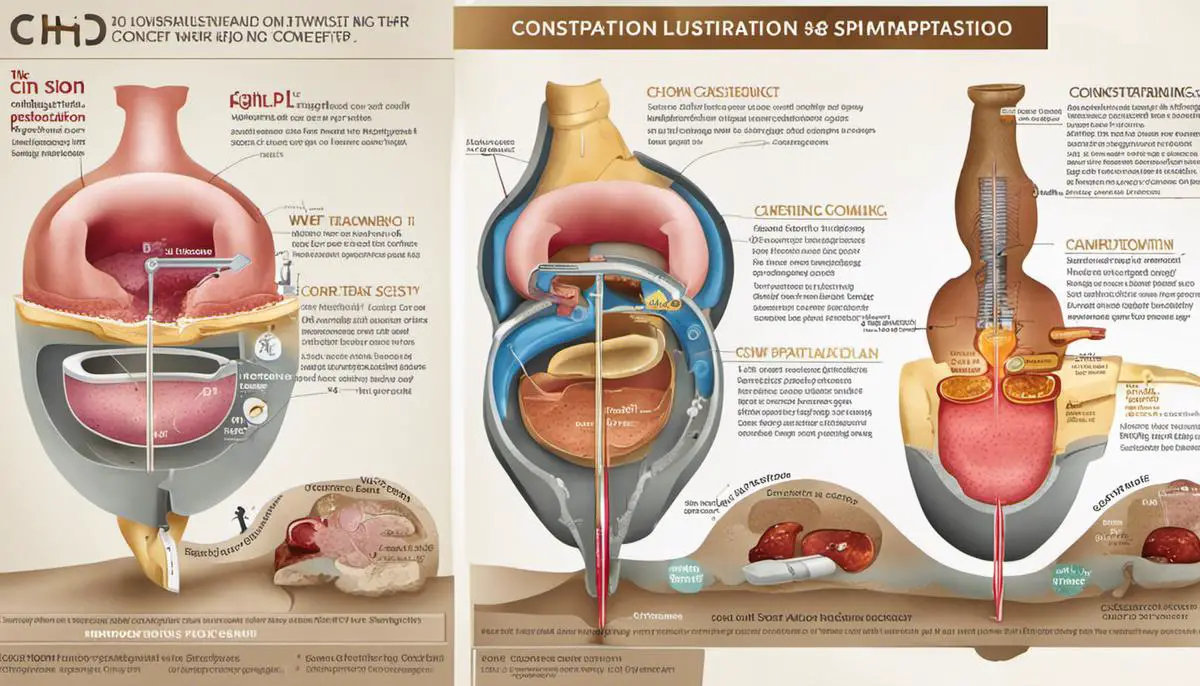Constipation, a common yet discomforting health issue, hampers the well-being and freedom of numerous people across the U.S. Faced with the probing challenge of using the right solution for this problem, individuals are often left in a state of confusion about which treatment or rescue operation to take up. This detailed exploration of constipation will enable you to grasp the concept well, understand its trigger points, its impacts on the body, and the factors contributing to its frequency in the American population. Furthermore, we will delve into multiple solutions ranging from life transformations to over-the-counter remedies, all aimed at alleviating this discomfort. An extensive focus will be given on one particular solution – stool softeners: their working mechanism, benefits, effectiveness, and precautions needed while using them.
Understanding Constipation
Understanding Constipation: An Overview
Constipation is a common health condition characterized by infrequency or difficulty in bowel movements (less than three times per week), hard or lumpy stool, or a sensation of incomplete bowel evacuation. While occasional constipation is quite normal, chronic constipation can interfere with a person’s daily activities and cause significant discomfort and distress.
Symptoms and Causes of Constipation
Full-blown constipation can manifest with a range of symptoms that include but are not limited to, dry or hard stools, straining during bowel movements, a feeling of incomplete evacuation, bloating, and abdominal pain. It may lead to complications like hemorrhoids, rectal bleeding, or even stool impaction (a blockage in the rectum with hard stool).
The causes of constipation are manifold. It may arise due to a lack of dietary fiber, decreased water intake, sedentary lifestyle, changes in routine or diet, stress, overuse of laxatives, certain medications, and various health conditions like Parkinson’s disease, diabetes, stroke, thyroid disease, or irritable bowel syndrome.
Risk Factors Associated with Constipation
There are several risk factors associated with constipation. Being elderly, female, dehydrated, or following a diet low in fiber are some risk factors. Constipation is more common during and after pregnancy. Certain psychological disorders like depression, eating disorders, or excessive anxiety may also contribute to chronic constipation.
Lifestyle and Dietary Factors Contributing to Constipation
Modern urbanized lifestyle contributes significantly to constipation in the U.S. Prolonged sitting, lack of physical activity and exercise, stress, and irregular meal timings are intrinsically linked with constipation. A diet low in fiber from fruits, vegetables, and whole grains, and high in fats, processed foods, and dairy products can cause constipation. Additionally, not drinking enough water or fluids can lead to hardening of the stool making it difficult to pass.
Health Factors Impacting Constipation
Numerous health and disease-related factors can cause constipation. Diseases that affect the nervous system (such as Parkinson’s disease or multiple sclerosis), metabolic and endocrine disorders (such as diabetes or hypothyroidism), systemic disorders affecting multiple organ systems, and certain bowel disorders (such as irritable bowel syndrome or tumors) can cause constipation. Many drugs, like antacids containing calcium or aluminum, antipsychotics, antihypertensives, certain painkillers and sedatives, can also contribute to constipation.
Role of Stool Softeners in Constipation
Stool softeners, also known as emollient laxatives, work by increasing the water content in the stool, making it soft, easier to pass, and reducing the need to strain. This provides gentle and effective relief from constipation. They may be especially helpful for people who need to avoid strain because of certain medical conditions, such as after heart surgery or childbirth. Typical stool softeners available include docusate sodium (Colace) and docusate calcium (Surfak). It’s important to drink plenty of water while taking a stool softener as the increased water helps the softener work more effectively.
While stool softeners are generally safe, they should be used as a temporary relief and not a long-term solution. Overuse can lead to bowel dependency, where the muscles in the colon become too accustomed to stool softeners’ assistance and depend on them to cause movements.
Consulting Your Healthcare Provider Is Key.
Often, more sustainable and healthful ways of effectively managing constipation come with lifestyle changes. This can include introducing a high-fiber diet and regular exercise into your routine. Yet, it’s essential to remember to always consult your healthcare provider before making any changes for personalized medical advice.

Treatments for Constipation
Comprehending Constipation and Its Various Treatments
Across the globe, constipation—defined as having fewer than three bowel movements per week, producing hard stools, or experiencing difficulty during evacuation—is a common, if uncomfortable, issue affecting a significant number of people. A myriad of factors can cause this condition, such as certain prescribed medications, a low-fiber diet, inadequate physical activity, or even specific mental health conditions. Consequently, the course of treatment can fluctuate depending upon the root cause of the constipation.
Lifestyle Changes and Dietary Modifications
Lifestyle changes such as increasing physical activity and maintaining a regular exercise routine can encourage regular bowel movements. It’s important to factor in hydration as well, as sufficient water intake helps soften your stools and supports overall gut health. Dietary modifications have their place in constipation treatment too. Increasing the intake of fiber-rich foods such as whole grains, fruits, vegetables, and legumes can also help treat constipation.
Prescription Drugs and Over-the-Counter Remedies
Depending on the severity and persistence of constipation, a doctor might prescribe or recommend over-the-counter laxatives. These include bulking agents, stimulant laxatives, osmotic laxatives, and stool softeners. It’s crucial to approach these treatments under the guidance of a healthcare professional to avoid dependency or harmful side effects.
A Focus on Stool Softeners
Stool softeners, also known as emollient laxatives, are a kind of laxative that works by increasing the water content of the stool, making it easier to pass. Stool softeners such as docusate sodium (Colace) and docusate calcium (Surfak) are widely available over-the-counter. They are generally considered safe for short-term use but should ideally be used under the supervision of a healthcare professional to avoid potential adverse effects.
The Role of Stool Softeners in Constipation Treatment
Stool softeners are particularly useful when hard, dry stools are the primary symptom of constipation. They are often recommended for those who should avoid straining during bowel movements, such as individuals who have recently had surgery, women who’ve given birth, or people with hemorrhoids. It’s important to note that stool softeners might not be as effective when constipation is due to a lack of dietary fiber or physical activity.
Safety and Side Effects of Stool Softeners
While these medications are available without a prescription, they should still be used judiciously. Long-term use of stool softeners can lead to an electrolyte imbalance, which can cause muscle weakness or abnormal heart rhythms. Some side effects may include stomach cramping, diarrhea, or a feeling of nausea. If these symptoms persist, immediate medical attention is advised.
Maintaining Healthy Bowel Function Naturally
To keep constipation at bay, staying well-hydrated and maintaining an active lifestyle can go a long way. Consuming ample amounts of fluids can help soften your stool, potentially reducing the need for stool softeners. Likewise, regular exercise can stimulate contractions in your intestines, facilitating more predictable bowel movements. Do bear in mind, however, these natural strategies should complement a balanced diet and are not intended to substitute medical treatments if required.

Stool Softeners as a Solution
The Science Behind Stool Softeners
Stool softeners, often referred to as emollient laxatives, provide relief from constipation by facilitating smoother bowel movements. They achieve this by increasing the water absorption of the stool in your intestines. This process makes your stool softer and easier to pass. Therefore, if you’re dealing with constipation symptoms featuring hard, dry stools that are difficult to pass, stool softeners might be a solution worth considering.
Benefits of Stool Softeners
One of the main benefits of stool softeners is that they can make bowel movements less painful. By softening stools and making them easier to pass, they reduce the strain associated with constipation. They also prevent the hardening of stools, which is often the main cause of hemorrhoids and anal fissures.
Stool softeners are also notably gentler on the body than some other types of laxatives. They provide a comparatively gentle relief from constipation and do not typically cause a sudden, urgent need to use the bathroom.
Side Effects of Stool Softeners
Common side effects of stool softeners include abdominal cramping, diarrhea, and nausea. Less frequent, but more serious side effects may include electrolyte imbalances and an allergic reaction. It is important to note that these side effects are more common when stool softeners are used over a long period.
Effectiveness of Stool Softeners
The effectiveness of stool softeners can vary based on the individual and the severity of constipation. They tend to be most effective when used for short-term relief, such as during a period of recovery from surgery or childbirth. However, they are not typically the best long-term solution for chronic constipation.
Who Can Use Stool Softeners
Stool softeners are generally safe for adults and children over the age of 6. However, they should not be the first choice for children unless recommended by a doctor. Pregnant women can also use certain types of stool softeners, but it’s always best to consult a healthcare provider. Elderly individuals may also benefit from stool softeners, as their risk of constipation increases with age.
A Look at the Different Types of Stool Softeners
An array of stool softeners is readily available for over-the-counter purchase. Docusate sodium, prominently known by the brand names Colace and Dulcolax, ranks as one of the most widespread stool softeners. Other varieties include Docusate calcium (Surfak) and Docusate potassium (Diocto-K and Kao-Tin). While they essentially share the same mode of action, minor variations may exist in their performance and potential side effects.
Before settling on a particular stool softener, it’s crucial to scrutinize the product packaging or engage a healthcare provider for advice to ensure it’s the most suitable option for your needs. If these over-the-counter selections fail to deliver the desired results, appoint a consultation with a healthcare provider for prescription-grade alternatives.

Usage and Precautions with Stool Softeners
Proper Approach to Using Stool Softeners
Stool softeners, otherwise known as emollients, are over-the-counter (OTC) medications that aid in softening the stool for easy passage. They achieve this by supplementing the water content in the stool, thereby facilitating smoother bowel movements and reducing discomfort. The main ingredient typically present in these softeners is docusate. These medications are available in different forms, such as liquids, tablets, and capsules.
Compliance with the instructions indicated on the package or those given by a healthcare professional is critical when using stool softeners. Typically, they are taken orally and should be accompanied by a full glass of water. The prescribed dosage is subject to the user’s age and health condition, but for adults, it usually ranges from 50-200 mg per day, distributed over 1-4 doses. Generally, it’s advised to take the medication at bedtime, though specific needs may dictate a different regimen.
When To Take and What to Avoid
The most common reason to take stool softeners is to alleviate symptoms of constipation. They can also be beneficial for those who’ve recently had surgery or childbirth, as straining could worsen their condition.
However, certain circumstances require caution. People should not rely on laxatives or stool softeners for long-term management of difficulties with bowel movements without first consulting with a provider. Also, it’s crucial to remember drinking plenty of water while using stool softeners. Since these drugs work by increasing the water content in the stool, dehydration can reduce their effectiveness.
As with any medication, certain substances should be avoided when taking stool softeners. Alcohol can increase the risk of dehydration and should be consumed in moderation. Additionally, specific prescription medications can potentially interact with stool softeners and may disrupt their function or increase side effects.
Possible Side Effects or Outcomes
While generally considered safe for most people, stool softeners can cause mild side effects. These can include abdominal cramping, diarrhea, nausea, or a sour stomach. Infrequently, there may be allergic reactions that can include a rash, itching, swelling, severe dizziness, and trouble breathing. If any of these side effects persist or worsen, seek immediate medical attention.
Seeking Medical Advice
While mild constipation is generally not cause for concern, if symptoms persist for an extended period (typically longer than a week), it’s necessary to seek medical advice. It’s also crucial to consult a healthcare professional if stomach pain, nausea, vomiting, or rectal bleeding accompany the constipation. Pregnant or breastfeeding women should consult with their healthcare provider before starting any new medication, including stool softeners.
It can also be beneficial to consider lifestyle changes that can promote regular bowel movement, such as a high fiber diet, regular exercise, or increased fluid intake. A healthcare professional can give advice tailored to individual needs and circumstances.

At the route of our exploration, we’ve highlighted the importance of assessing one’s own body, lifestyle, and diet in managing constipation. While multiple approaches exist to alleviate constipation’s effects, we’ve discussed in detail the function and impact of stool softeners as one potential solution. It’s necessary to remember that while using stool softeners, they should be taken correctly with proper precautions to avoid adverse effects. Though they can be an effective treatment for some, consulting a healthcare professional before starting a regimen can prevent potential health risks and complications. The ultimate aim is to strive towards a healthier, well-aware lifestyle that can help combat constipation and bolster overall gut health.
